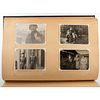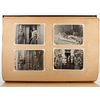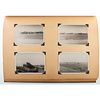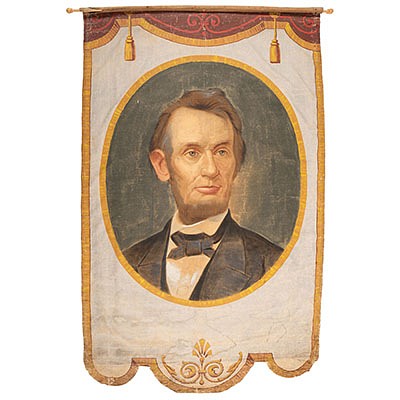[WORLD WAR II]. Late-War album containing over 330 photographs with extensive images of aircraft and artillery.
About Seller
6270 Este Ave.
Cincinnati , OH 45232
United States
With offices in Cincinnati, Cleveland and Denver, Cowan’s holds over 40 auctions each year, with annual sales exceeding $16M. We reach buyers around the globe, and take pride in our reputation for integrity, customer service and great results. A full-service house, Cowan’s Auctions specializes in Am...Read more
Two ways to bid:
- Leave a max absentee bid and the platform will bid on your behalf up to your maximum bid during the live auction.
- Bid live during the auction and your bids will be submitted real-time to the auctioneer.
Bid Increments
| Price | Bid Increment |
|---|---|
| $0 | $25 |
| $500 | $50 |
| $1,000 | $100 |
| $2,000 | $250 |
| $5,000 | $500 |
| $10,000 | $1,000 |
| $20,000 | $2,500 |
| $50,000 | $5,000 |
| $100,000 | $10,000 |
About Auction
Jun 25, 2021
The June 25 American Historical Ephemera and Photography Auction features an exciting assemblage of 18th-early 20th century material, including Civil War archives, Early Photography, Western Americana, Autographs and Manuscripts, and more. Cowan's Auctions dawnie@cowans.com
- Lot Description
Approximately 331 photographs, most 4 5/8 x3 1/4 in. (occasional fading); 11 x 15 in. scrapbook album, black cloth boards gilt, string-bound (mounting pages toned, small loss on rear board).
A pencil inscription on the front interior board is labeled "3rd Army, 133rd AA," likely an Anti-Aircraft division, which accounts for the extensive collection of images of downed aircraft, Luftwaffe planes, flak guns, and other anti-aircraft artillery pieces. Early images, labeled "English Channel" show troops in transport boats. The photographs were taken in 1945 and demonstrate interesting examples of late-war experimental technologies. For example, two interesting images show a Mistel composite aircraft configuration with a Focke-Wulf Fw 190 (Werk Nr. 561243) mounted on what appears to be a Junkers Ju 88 (Werk Nr. 460066). The smaller, piloted fighter was mounted above the larger plane loaded as an explosives-carrying drone. Mounted with ball joints with explosive bolts (Kugelverschraubung mit Sprengbolzen), the pilot would release the lower craft to act as a bomb. Mistel configurations, also referred to as Huckepack ("Piggyback"), Beethoven-Gerät (Beethoven Device), or Vati und Sohn ("Daddy and Son"), were first used in July 1943, and initiated a Luftwaffe test unit KG 200 (nickname "Beethoven"). Some 250 composites were built but were of limited success. In 1945, British forces captured the same Mistel configuration of a Focke-Wulf Fw 190 (Werk Nr. 733682) and Junker Ju 88 shown here in 1945, now held in the Imperial War Museum.
Other images show several Messerschmitt Bf 109s and Heinkel He 111 bombers. A series of 3 images show a light forward observer plane downed in a field with a fourth image showing the presumed Captain prone. Another series of 12 images shows the obliterated wreckage of German aircraft, pencil labeled "German Paratroop Plane." In one image, Allied soldiers stand near the wreckage and the corpses of the plane's captains are visible.
Several images also include various artillery pieces. In a series taken at what appears to be a captured Luftwaffe airfield, there is an image of an 8.8 cm Flak 18/36/37/41 German anti-aircraft and anti-tank artillery gun. Positioned under camouflage netting, it was almost certainly used in an anti-aircraft capacity here. Labeled in pencil, "Loaded with dynomite [sic]," an image shows a small vehicle with tank-like treads. No more than a foot tall, the diminutive vehicle was possibly experimental drone technology. A series of 4 photographs show soldiers operating an unmounted recoilless rifle in a field. Typically mounted on jeeps or other vehicles, this rifle is set up in a field. The fourth image is taken after discharge, showing a large cloud of smoke.
Many of the photographs, taken in France, Germany, and throughout Europe show the destruction of the War in cities, towns, and the countryside. Near the end of the album, the soldier had the opportunity to visit tourist locations with images of Luxembourg, the Ponte Vecchio in Florence, Italy, the Palace at Versailles, as well as Omaha Beach (labeled in pencil). The last images of the album, labeled "Russian Troops" show Soviet soldiers on horseback and riding in horsedrawn wagons on a country road.
composite planeCondition
fly the top
with the lower plane acting as a bomb
Junkers Ju 88 bomber
Heinkel 219 - Shipping Info
-
SHIPPING & PICKUPS Cowan’s Cincinnati Office offers an in-house, full-service shipping department which is unparalleled in the auction industry. Shipping costs are provided with your finalized invoice 24-48 hours after auction. For furniture and oversized items, we recommend using third-party services. For more information, contact cowansshipping@hindmanauctions.com. NOTE: All pickups and preview are by appointment only. To make an appointment, please call 513-871-1670 or email cincinnati@hindmanauctions.com Buyers are required to pay for all packing, shipping and insurance charges. Overseas duty charges are the responsibility of the successful Bidder. Be aware that for larger and/or valuable items, shipping charges can be substantial. - Shipping charges include insurance for your order while in transit. If you have private insurance we will adjust your charge to include only packing and shipping. - Please allow 14 – 21 days after payment to package and ship your purchase as carefully as possible.
-
- Buyer's Premium



 EUR
EUR CAD
CAD AUD
AUD GBP
GBP MXN
MXN HKD
HKD CNY
CNY MYR
MYR SEK
SEK SGD
SGD CHF
CHF THB
THB![[WORLD WAR II]. Late-War album containing over 330 photographs with extensive images of aircraft and artillery.](https://s1.img.bidsquare.com/item/l/8590/8590175.jpeg?t=1LMYl5)
![[WORLD WAR II]. Late-War album containing over 330 photographs with extensive images of aircraft and artillery.](https://s1.img.bidsquare.com/item/s/8590/8590175.jpeg?t=1LMYl5)
















